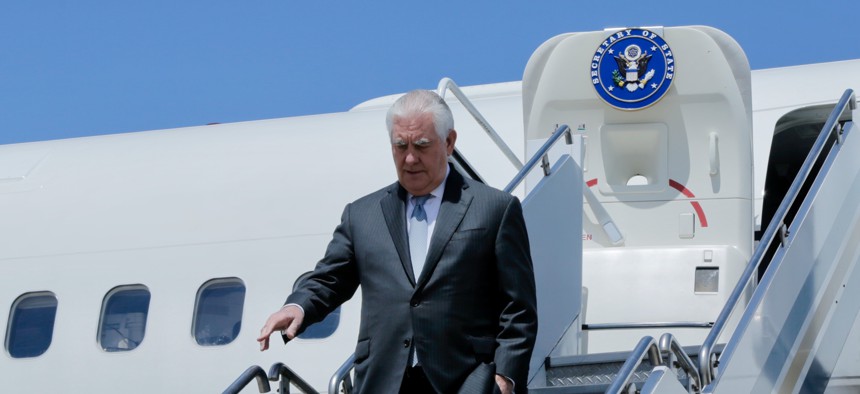
U.S. Secretary of State Rex Tillerson arrives in Buenos Aires, Argentina, on February 4, 2018. State Department
State Department Lost 12% of its Foreign Affairs Specialists in Trump’s First 8 Months
The department also lost 6 percent of its overall workforce in the first year of the new administration.
The State Department’s civilian workforce shrunk more than 6 percent overall during the initial eight months of the Trump administration, but that figure masks significantly higher departure rates in critical areas of the country’s diplomatic apparatus.
In December 2016, the department employed 2,580 people under the foreign affairs occupation series, according to data from the Office of Personnel Management. By September 2017—the most recent data available—that number fell to 2,273, a decrease of roughly 11.9 percent.
Most employees under the series serve as foreign affairs officers, a broad role that encompasses responsibilities such as advising, administering and researching foreign policy areas like trade, drug trafficking, arms control and the environment. Foreign affairs officers also serve as key figures in international negotiations.
Foreign affairs employees made up more than 40 percent of the 836 civilians who left the State Department between January 1, 2017, and September 30, 2017—the final month of the Obama administration and the first eight months of the Trump administration.
The drop off in foreign affairs officers reflects a larger overall trend in Secretary of State Rex Tillerson’s treatment of his agency’s career workforce, said Ron Neumann, a retired 37-year State Department veteran who served as ambassador to Algeria, Bahrain and Afghanistan. The most recent administration appears to have a unique “contempt” for the career workforce, Neumann told Government Executive, prompting many top policy experts to leave the government’s diplomatic arm, whether they want to or not.
The overall civilian workforce at the State Department shrunk roughly 6.3 percent between September 2016 and September 2017, according to OPM data. Though the plurality of departures came in foreign affairs positions, the number of employees serving in administrative and legal jobs dropped 5.4 percent.
Though Neumann noted every White House transition brings shake-ups in Foggy Bottom, it’s rare for job openings to stay empty this far into a new administration. In fact, the civilian workforce grew roughly 0.6 percent during the one-year transition from George W. Bush to Barack Obama and more than 3.4 percent during the move from Bill Clinton to Bush.
Lawmakers and diplomats have voiced concerns that State will meet significant proposed budget cuts with dramatic personnel reductions, but Tillerson said he will rely on attrition and buyouts rather than layoffs to thin the agency’s workforce.
“We have not targeted any workforce reduction measures that would affect Civil Service Foreign Affairs Officers any differently than other Civil Service employees,” a State Department spokesperson said in an email to Government Executive.
Agency officials told Politico the rhetoric around reorganization has shifted from sweeping personnel cuts to upgraded technology and improved training.
Whether intended or not, Tillerson’s strategy has led to a disproportionate number of departures in the agency’s most experienced ranks. State saw 16.2 percent of civilian employees with 25 or more years of service leave between December 2016 and September 2017, and the number of foreign affairs series employees with at least 25-year tenures shrunk 13.1 percent during that period.
But while seasoned employees are walking out the door, few fresh faces are coming in. Tillerson has kept the Trump administration’s initial hiring freeze in place despite lawmakers' pleas to end it.
“You’re throwing out the people at the top, so you’re losing expertise,” Neumann said. “If you don’t bring in people at the bottom . . . you’re setting up a long-term problem.”
The agency’s foreign service workforce—which includes American diplomats and support staff—also shrank during the first year under Tillerson. Though its total size decreased only 1.2 percent, the drop was more drastic among those directly involved in policymaking.
The State Department lost 166 Foreign Service officers—roughly 2 percent of the total—from December 2016 to December 2017, according to agency data. Officers are responsible for most of the heavy lifting in political, economic and diplomatic relations abroad, and while their numbers have declined, their support staff remains roughly the same size. The Foreign Service specialist corps—which performs IT, security, human resources and courier duties—has only experienced a net loss of four employees.
Neumann said the departures of professional diplomats and policy experts within the civilian workforce could potentially leave the country “vulnerable to bad deals,” particularly in highly technical areas.
“Other countries are represented by people who have a deep background in the issue … and you’re like the high school kid trying to pretend you’re in college,” he added.




